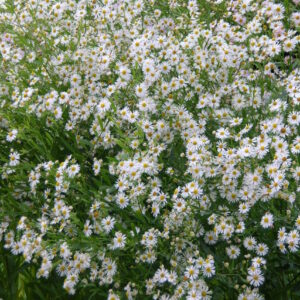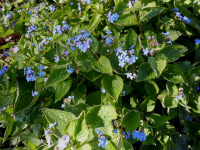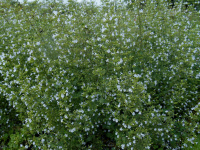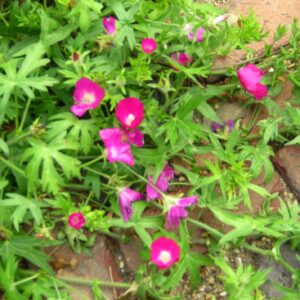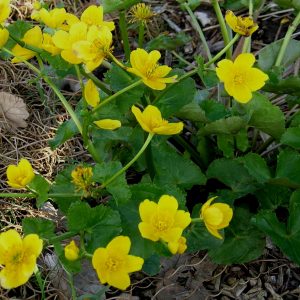Perennials & Biennials
Showing 89–96 of 511 results
-
Bletilla striata syn. B. hyacinthina Chinese ground orchid Z 5-9
Racemes of pinkish-purple flowers on scapes above dark green, upright, lance-shaped leaves, April-May
OUT OF STOCK
Racemes of pinkish-purple flowers on scapes above dark green, upright, lance-shaped leaves, April-May
Size: 12-18” x 12”
Care: Part shade in moist, well-drained soil.
Native: China, Japan
Wildlife Value: Attracts bees, butterflies and hummingbirds. Deer & Rabbit resistant.
Awards: Royal Horticultural Society Award of Garden MeritProtect with thick winter mulch, may not reliably survive Zone 5 winters.
Spreads slowly by rhizomes and seeds in optimal conditions.
‘Bletilla’ honors Louis Blet, a Spanish apothecary in Algeciras who also had a botanic garden at the end of the 18th century. Collected before 1784 by Thunberg. -
Boltonia asteroides False starwort, Bolton’s aster Z 4-9
“Bloom profusely” majestic, white daisies cover imposing, cheerful plant, August – September
“Bloom profusely” majestic, white daisies cover imposing, cheerful plant, August – September
Size: 5-6' x 3'
Care: full sun to part shade in moist well-drained soil.
Native: Maine to Florida, west to Texas and north to North Dakota and all areas in between, Wisconsin
Wildlife Value: provides pollen to over 40 bee species, moths, butterflies and wasps.Named in honor of 18th century English botanist, James Bolton. Asteroides means resembling as aster. Species introduced in 1758. Recommended for fall blooms in Wisconsin State Horticultural Society Annual Report, 1911.
-
Bouteloua curtipendula Sideoats grama Z 4-8
Narrow, blue-green leaves tinged purple or red in fall when golden oat-like seeds hang down one side of each leaf, eye-catching.
Narrow, blue-green leaves tinged purple or red in fall when golden oat-like seeds hang down one side of each leaf, eye-catching.
Size: 2-3' x 1'
Care: Sun in well-drained to moist well-drained soil, drought tolerant
Native: most of US, incl. Wisconsin
Wildlife Value: nesting material for butterflies and bees; larval host for some Skipper butterflies,
Awards: state grass of TexasKiowa natives who had killed an enemy in battle with a lance wore this. Collected and described by French planthunter André Michaux (1786-1802) who scoured Eastern North America west to the Mississippi over 11 years.
-
Brunnera macrophyllum Siberian bugloss Z 3-7
Panicles of robin's egg blue forget-me-not- type flowers in May and June, contrast with bold, round foliage. One of the best spring flowers.
Panicles of robin’s egg blue forget-me-not- type flowers in May and June, contrast with bold, round foliage. One of the best spring flowers.
Size: 12" x 12"
Care: part shade to shade in moist to moist well-drained soil
Native: Caucasus & Siberia
Awards: Royal Horticultural Society Award of Garden MeritNamed for Swiss botanist Samuel Brunner (1790-1844). Collected by Russian botanist Johann Friedrich Adam (1780-1838) in Siberia c. 1806.
-
Calamintha nepeta ssp. nepeta syn. Clinopodium nepeta ssp. nepeta Lesser calamint Z 4-9
Profuse violet blooms on mint-scented, gray-green foliage gives frosty image, June-October
Profuse violet blooms on mint-scented, gray-green foliage gives frosty image, June-October
Size: 18-24” x 8-12”
Native: Europe and Mediterranean
Wildlife Value: attracts bees, butterflies and hummingbirdsThis subspecies 1st described by Linnaeus in 1753. Genus name comes from Greek kalos meaning beautiful and minthe meaning mint. It is not, however, a mint and is not invasive.
-
Callirhoe digitata Finger poppy mallow Z 5-8
Purple-red cups wave atop leafless stems all summer.
OUT OF STOCK – EMAIL FOR AVAILABILITY
Purple-red cups wave atop leafless stems all summer.
Size: 1-3’ x 1’
Care: full sun in moist well-drained soil
Native: Missouri and Kansas to Arkansas & TexasCallirhoe is named for the goddess Callirhoe, daughter of Hermocrates, the Greek river god. Digitata means shaped like an open hand (digits = fingers). First collected by Englishman Thomas Nuttall, trained as a printer, turned extraordinary plant hunter who looked for plants from the east coast throughout the Midwest, Arkansas, Florida, to the Pacific Northwest and Hawaii (1786-1859).
-
Callirhoe involucrata Wine cups, Prairie poppy mallow
Magenta-purple upfacing cups, June - October
Magenta-purple upfacing cups, June – October, non-stop. Wonderful for rock gardens or as a ground cover.
Size: 6" x 12"
Care: Full sun in well-drained soil. Drought tolerant
Native: Missouri to TexasAlthough an American prairie native, Callirhoe is named for the daughter of the Greek river god. Teton Dakota burned its dried root for smoke to cure the common cold and aches and pains. First collected by Thomas Nuttall in 1834. Ferry’s 1876 catalog described it as having “a trailing habit, of great beauty.” William Robinson extolled Prairie mallow as “excellent for the rock garden, bearing a continuous crop of showy blossoms from early summer till late in autumn.”
-
Caltha palustris Marsh marigold, Kingscup Zones 3-7
Finch yellow buttercups in early spring top round, kidney-shaped foliage
Finch yellow buttercups in early spring top round, kidney-shaped foliage
Size: 12-18” x 12-18”
Care: sun to part shade in moist, acidic soil
Native: Maine to No. Dakota S. to Tennessee
Wildlife Value: Attracts birds
Size: Caltha is Latin meaning “cup” and palustris means “boggy” or “marsh.” America’s 1st people used the roots medicinally to cure colds and sores and to induce vomiting. The roots also protected against “love charms,” (but I suspect the vomiting might have accomplished that.) An infusion of leaves remedied constipation.Introduced to Europe very early and memorialized in Chaucer’s poetry, 1549. Grown in the Eichstätt Garden, the garden of Johann Konrad von Gemmingen, prince bishop of Eichstätt in Bavaria, c. 1600.
LH Bailey considered the flowers “very beautiful,” while Rand called them “very showy.” Wm. Robinson described them as “shin(ing) like fires in swamps and hollows.” Pressed specimen in Emily Dickinson’s herbarium.


